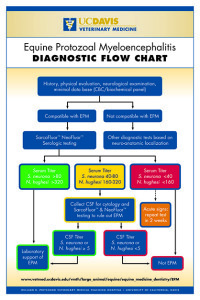Flow Chart For Diagnosing EPM in Horses
UC Davis School of Veterinary Medicine
While it may not seem difficult to visually identify a horse as neurologic, diagnosing equine protozoal myeloencephalitis (EPM) can be a detailed process of evaluating the history, physical examination, and neurological examination of the horse. To assist veterinarians in diagnosing EPM, the Veterinary Medical Teaching Hospital at the University of California, Davis has created several resources that will help trained equine veterinarians determine if their patients may be suffering from the debilitating neurologic disease.
“We discussed our EPM research and clinical activities extensively at last year’s American Association of Equine Practitioners Convention,” said Dr. Nicola Pusterla, DVM, PhD, DACVIM, chief of UC Davis’ Equine Medicine Service. “What we discovered was that many veterinarians wanted assistance in properly diagnosing the disease, as it can be masked as many other possible conditions.”
In response to the multitude of requests, UC Davis has developed a website full of resources for veterinarians who suspect their patients may have EPM. The site (which can be found at: www.vetmed.ucdavis.edu/vmth/large_animal/equine/equine_medicine_dentistry/EPM) includes:
• Diagnostic flow chart which walks veterinarians through several steps, ultimately to a positive or negative outcome
• Detailed procedure for performing a neurologic examination
• Videos showing differing levels of neurologic horses
• EPM laboratory testing available at UC Davis
• Research study conducted by UC Davis outlining the prevalence of EPM throughout the United States
After obtaining more than 3,000 diagnostic submissions from across the United States, UC Davis determined that horses from 42 states were affected by parasites causing EPM. Originally believed to be a regionalized disease, EPM has proven to be far more widespread than first thought. UC Davis researchers are extending that study, and believe they will find even more evidence of the disease spreading to previously unsuspected parts of the country.
About the Veterinary Medical Teaching Hospital
The William R. Pritchard Veterinary Medical Teaching Hospital at the University of California, Davis—a unit of the School of Veterinary Medicine—provides state-of-the-art clinical care while serving as the primary clinical teaching experience for DVM students and post graduate veterinarian residents. The VMTH treats more than 47,000 animals a year, ranging from cats and dogs to horses, cows and exotic species. To learn more about the VMTH, please go to www.vetmed.ucdavis.edu/vmth. Timely news updates can be received on its Facebook (www.facebook.com/ucdavisvetmed) and Twitter (www.twitter.com/ucdavisvetmed) pages.












